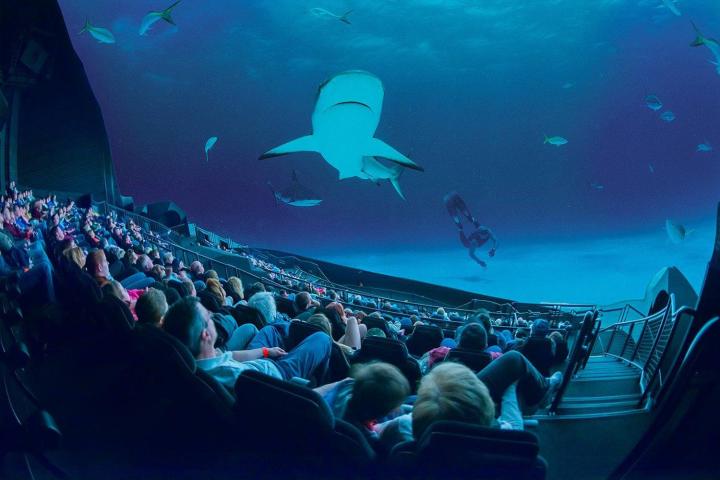
Update 8/19/2014 by Caleb Denison: This article has been updated pursuant to a conversation with IMAX executives clarifying points on screen sizes, field of view, and parties responsible for ticket prices
In other words: not all IMAX screen sizes are created equal — yet the ticket prices are.
Once limited to specialized locations like science museums and theme parks, IMAX theaters from the Canadian company of the same name now can be found in over 800 outlets across 57 countries. IMAX theaters now feature more than just edu-tainment films about dinosaurs and sea monsters, too. You can instead catch some of the same blockbuster fare as regular theaters, only enhanced by IMAX’s high-tech sound and imagery, and the massive screen size.
Related: IMAX will build you a home theater for $1 million
But just how massive is that IMAX screen supposed to be? If you feel like you’ve been duped by your latest IMAX experience, it’s not your imagination. In many locations, the screens really are getting smaller — a lot smaller. And it’s been happening on the sly for a while now. In a 2010 report, the LFExaminer outlined the wide difference between screen sizes viewers can expect to encounter from one IMAX theater to the next.
Less screen for your green
The largest IMAX screen from the early days in the ’70s was an enormous 60 feet high by 82 feet wide. That’s around 6 stories tall, representing almost 5,000 square feet of surface area — a cinematic utopia. Today many IMAX screens have shrunk to a fraction of those old monsters’ size, however, offering as little as 1,103 square feet of screen real estate. That’s a serious difference. And the worst part is, you’ll likely pay the same ticket price for any IMAX screen you’ll encounter in your market, no matter its size.
If we break things down in terms of screen size per dollar, assuming an $18 average ticket price, that’s a difference of 277 feet per dollar for the largest screen vs. 61 feet per dollar for the smallest. If there was a supermarket-style sign posted at the box office with this information, you’d want the better deal, right?

The amount you pay to watch a show in an IMAX theater does not rest entirely on IMAX, though. When it comes to ticket prices, IMAX doesn’t directly set the price, that’s up the the theater owner. If two different IMAX theater locations with different screen sizes are owned by the same operator but demand the same ticket price, that’s because the theater owner decided it should be that way.
However, it should be noted that IMAX theaters involve a great deal of high-end technology, and that technology is more expensive to own and operate than the equipment found in neighboring theater rooms. There’s a whole lot more to an IMAX theater than just a big screen, and that cost is going to trickle down to the consumer. Perhaps theater owners could stand to charge a lower amount for theaters with smaller screens, but the difference in ticket price would likely be negligible.
Size matters
According to the LFexaminer, when IMAX went digital for its projectors it also began decreasing screen sizes at a rapid pace. It was then that the company also publicly stepped away from its big screen reputation, ostensibly focusing on its proprietary technology as the selling point instead. Speaking to the Giant Screen Cinema Association, IMAX CEO Richard Gelfond put it very succinctly: “We don’t think of (IMAX) as the giant screen.”
Ok, but why the big change?
Simply put, IMAX is a business interested in growth and profitability. Like any good company, it wants to expand its reach, propagate its brand, and grow its fan base among moviegoers. The problem is, expansion is difficult when there are only so many venues that can host massive multi-story screens. In order for IMAX to fit into more theaters, screen sizes had to be scalable. This brings a certain challenge: how do you continue to deliver that feeling of being totally immersed in a film by a screen that dominates you, but with a smaller screen? IMAX’s answer: move the screen closer to the viewer.
In an interview with Digital Trends, IMAX’s Chief Technology Officer, Brian Bonnick, explained that a smaller screen can still have a huge impact if it fills or exceeds your field of view. “There’s no question, if you walk into a room and you’re six feet tall and the screen is eight stories tall, that relationship has an impact on you,” Bonnick admits. “However, the other part that has an impact on you is your field of view. In other words, if I took a screen and made it a mile high and a mile wide, but I put it 20 miles away from you, it wouldn’t look very big. And if I took … a screen that was one foot wide and one foot tall, and put it three inches from your face, that 1-foot wide screen would be so much larger in your perspective — because it’s filling your peripheral vision — than that mile-wide screen.”
In other words, IMAX knows it can completely consume your field of vision with a smaller screen if the screen is close enough to you. And IMAX can pull that off without you seeing the dreaded “screen door” effect due to the fact that it always uses two projectors which are able to pull off some pretty fancy tricks with the pixels being displayed on the screen. The result is a dominating image with excellent sharpness and resolution. In theory, this should deliver the same experience as a larger screen in a larger theater that you must sit further away from.
IMAX maintains its experience is about a lot more than just a big screen. The company goes to great lengths to ensure the best quality picture (not just the biggest one) and sound quality, utilizing all sorts of advanced analog and digital means. The company is about delivering the best experience possible, not just the biggest.
Of course, there’s a big problem with that. Although IMAX theaters utilize a host of technologies, all of which set them apart from “other” theaters, the viewing public – regular moviegoers like you and me – almost unequivocally do think of IMAX as “the giant screen,” and that’s what they walk in expecting. Perhaps the most troubling part of all this is, there’s no easy way to know what size of screen you might be walking into. IMAX theaters all bear the IMAX logo, but without any notable differentiation between the massive screens and their miniature counterparts.
Related: Dolby Atmos surround sound explained
It’s no secret that going out to the movies costs a lot these days. The addition of new surround formats like Dolby Atmos, and the addition of 3D films especially, have driven up box office sales figures, even as people have increasingly turned to the convenience and solitude of their home theaters.
But the splendor and sheer visual impact of a true, large-scale IMAX theater experience cannot be overestimated. And there are still plenty of massive IMAX theaters out there to experience. In fact, while some theaters have gotten much smaller, others have gotten a lot bigger as well. The biggest screen in the world in Sydney, Australia, for instance, is over 97 feet high and 117 feet wide, totaling a humungous 11,350 square feet of gleaming IMAX entertainment. Bam.
Now you know that IMAX, as you may have envisioned it, doesn’t always mean the same thing. However, instead of stepping away from the big, big screen, we recommend simply doing your research first. The information often isn’t readily available in regular online searches, so you may just have to ask your local theater manager. IMAX can still be an incredibly exhilarating cinematic event – just make sure you’re getting all the exhilaration you’re paying for.


